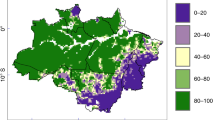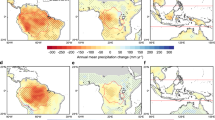Abstract
Vegetation change plays a critical role in the Earth’s carbon (C) budget and its associated radiative forcing in response to anthropogenic and natural climate change1,2,3,4. Existing global estimates of aboveground biomass carbon (ABC) based on field survey data provide brief snapshots that are mainly limited to forest ecosystems5,6,7,8. Here we use an entirely new remote sensing approach to derive global ABC estimates for both forest and non-forest biomes during the past two decades from satellite passive microwave observations. We estimate a global average ABC of 362 PgC over the period 1998–2002, of which 65% is in forests and 17% in savannahs. Over the period 1993–2012, an estimated −0.07 PgC yr−1 ABC was lost globally, mostly resulting from the loss of tropical forests (−0.26 PgC yr−1) and net gains in mixed forests over boreal and temperate regions (+0.13 PgC yr−1) and tropical savannahs and shrublands (+0.05 PgC yr−1). Interannual ABC patterns are greatly influenced by the strong response of water-limited ecosystems to rainfall variability, particularly savannahs. From 2003 onwards, forest in Russia and China expanded and tropical deforestation declined. Increased ABC associated with wetter conditions in the savannahs of northern Australia and southern Africa reversed global ABC loss, leading to an overall gain, consistent with trends in the global carbon sink reported in recent studies1,3,9.
This is a preview of subscription content, access via your institution
Access options
Subscribe to this journal
Receive 12 print issues and online access
$209.00 per year
only $17.42 per issue
Buy this article
- Purchase on Springer Link
- Instant access to full article PDF
Prices may be subject to local taxes which are calculated during checkout



Similar content being viewed by others
References
Le Quéré, C. et al. Global carbon budget 2013. Earth Syst. Sci. Data 6, 235–263 (2014).
Le Quéré, C. et al. Trends in the sources and sinks of carbon dioxide. Nature Geosci. 2, 831–836 (2009).
Canadell, J. G. et al. Contributions to accelerating atmospheric CO2 growth from economic activity, carbon intensity, and efficiency of natural sinks. Proc. Natl Acad. Sci. USA 104, 18866–18870 (2007).
Peters, G. P. et al. The challenge to keep global warming below 2 °C. Nature Clim. Change 3, 4–6 (2013).
Pan, Y. D. et al. A large and persistent carbon sink in the world’s forests. Science 333, 988–993 (2011).
Saatchi, S. S. et al. Benchmark map of forest carbon stocks in tropical regions across three continents. Proc. Natl Acad. Sci. USA 108, 9899–9904 (2011).
Baccini, A. et al. Estimated carbon dioxide emissions from tropical deforestation improved by carbon-density maps. Nature Clim. Change 2, 182–185 (2012).
Harris, N. L. et al. Baseline map of carbon emissions from deforestation in tropical regions. Science 336, 1573–1576 (2012).
Peylin, P. et al. Global atmospheric carbon budget: Results from an ensemble of atmospheric CO2 inversions. Biogeosciences 10, 6699–6720 (2013).
Jackson, T. J. & Schmugge, T. J. Vegetation effects on the microwave emission of soils. Remote Sens. Environ. 36, 203–212 (1991).
Kerr, Y. H. & Njoku, E. G. A semiempirical model for interpreting microwave emission from semiarid land surfaces as seen from space. IEEE Trans. Geosci. Remote Sensing 28, 384–393 (1990).
Guglielmetti, M. et al. Measured microwave radiative transfer properties of a deciduous forest canopy. Remote Sens. Environ. 109, 523–532 (2007).
Owe, M., De Jeu, R. & Walker, J. A methodology for surface soil moisture and vegetation optical depth retrieval using the microwave polarization difference index. IEEE Trans. Geosci. Remote Sensing 39, 1643–1654 (2001).
Liu, Y. Y., de Jeu, R. A. M., McCabe, M. F., Evans, J. P. & van Dijk, A. I. J. M. Global long-term passive microwave satellite-based retrievals of vegetation optical depth. Geophys. Res. Lett. 38, L18402 (2011).
Sellers, P. J. Canopy reflectance, photosynthesis and transpiration. Int. J. Remote Sensing 6, 1335–1372 (1985).
Friedl, M. A. et al. MODIS Collection 5 global land cover: Algorithm refinements and characterization of new datasets. Remote Sens. Environ. 114, 168–182 (2010).
Liu, Y. Y., van Dijk, A. I. J. M., McCabe, M. F., Evans, J. P. & de Jeu, R. A. M. Global vegetation biomass change (1988–2008) and attribution to environmental and human drivers. Glob. Ecol. Biogeogr. 22, 692–705 (2013).
Koren, I., Remer, L. A. & Longo, K. Reversal of trend of biomass burning in the Amazon. Geophys. Res. Lett. 34, L20404 (2007).
Zamolodchikov, D. G., Grabovskii, V. I. & Kraev, G. N. A twenty year retrospective on the forest carbon dynamics in Russia. Contemp. Probl. Ecol. 4, 706–715 (2011).
Fang, J. et al. Forest biomass carbon sinks in East Asia, with special reference to the relative contributions of forest expansion and forest growth. Glob. Change Biol. 20, 2019–2030 (2014).
Liu, Y., de Jeu, R. A. M., van Dijk, A. I. J. M. & Owe, M. TRMM-TMI satellite observed soil moisture and vegetation density (1998–2005) show strong connection with El Niño in eastern Australia. Geophys. Res. Lett. 34, L15401 (2007).
Miralles, D. G. et al. El Niño–La Niña cycle and recent trends in continental evaporation. Nature Clim. Change 4, 122–126 (2014).
Kim, W., Yeh, S. W., Kim, J. H., Kug, J. S. & Kwon, M. The unique 2009–2010 El Niño event: A fast phase transition of warm pool El Niño to La Niña. Geophys. Res. Lett. 38, L15809 (2011).
Bond, W. J. & Midgley, G. F. Carbon dioxide and the uneasy interactions of trees and savannah grasses. Phil. Trans. R. Soc. B 367, 601–612 (2012).
Friedlingstein, P. et al. Update on CO2 emissions. Nature Geosci. 3, 811–812 (2010).
Robinson, D. Implications of a large global root biomass for carbon sink estimates and for soil carbon dynamics. Phil. Trans. R. Soc. B 274, 2753–2759 (2007).
Buitenwerf, R., Bond, W. J., Stevens, N. & Trollope, W. S. W. Increased tree densities in South African savannas: > 50 years of data suggests CO2 as a driver. Glob. Change Biol. 18, 675–684 (2012).
Poulter, B. et al. Contribution of semi-arid ecosystems to interannual variability of the global carbon cycle. Nature 509, 600–603 (2014).
Zhao, M. & Running, S. W. Drought-induced reduction in global terrestrial net primary production from 2000 through 2009. Science 329, 940–943 (2010).
Schneider, U. et al. GPCC Full Data Reanalysis Version 6.0 at 1.0°: Monthly Land-Surface Precipitation from Rain-Gauges built on GTS-based and Historic Data (GPCC, 2011); http://dx.doi.org/10.5676/DWD_GPCC/FD_M_V6_100
Acknowledgements
Y.Y.L. is the recipient of an Australian Research Council Discovery Early Career Researcher Award (DECRA) Fellowship (project number DE140100200). J.G.C. acknowledges the support of the Australian Climate Change Science Program. M.F.M. is funded by the King Abdullah University of Science and Technology. G.W. is supported by the National Natural Science Foundation of China (numbers 41375099 and 91337108). We thank Y. Pan for helping to interpret forest inventory data and S. Saatchi for providing the aboveground biomass map for tropical regions.
Author information
Authors and Affiliations
Contributions
All authors contributed to the development of the paper. Y.Y.L. and A.I.J.M.v.D. designed the study. R.A.M.d.J., Y.Y.L. and G.W. prepared the VOD data set. Y.Y.L. conducted the analysis and wrote the Supplementary Information. A.I.J.M.v.D. and J.G.C. summarized the results and wrote the first draft of the paper, with subsequent addition and improvement by all authors.
Corresponding author
Ethics declarations
Competing interests
The authors declare no competing financial interests.
Supplementary information
Rights and permissions
About this article
Cite this article
Liu, Y., van Dijk, A., de Jeu, R. et al. Recent reversal in loss of global terrestrial biomass. Nature Clim Change 5, 470–474 (2015). https://doi.org/10.1038/nclimate2581
Received:
Accepted:
Published:
Issue Date:
DOI: https://doi.org/10.1038/nclimate2581
This article is cited by
-
The impact of land cover change on the carbon stock of moist afromontane forests in the Majang Forest Biosphere Reserve
Carbon Balance and Management (2023)
-
Changes in land use and management led to a decline in Eastern Europe’s terrestrial carbon sink
Communications Earth & Environment (2023)
-
Increasingly negative tropical water–interannual CO2 growth rate coupling
Nature (2023)
-
Asymmetry of carbon sequestrations by plant and soil after forestation regulated by soil nitrogen
Nature Communications (2023)
-
Siberian carbon sink reduced by forest disturbances
Nature Geoscience (2023)



